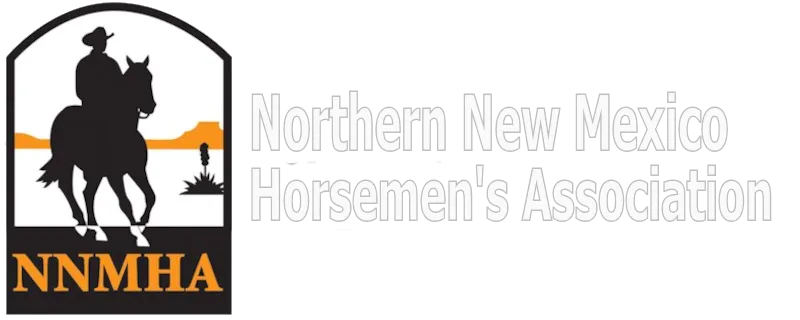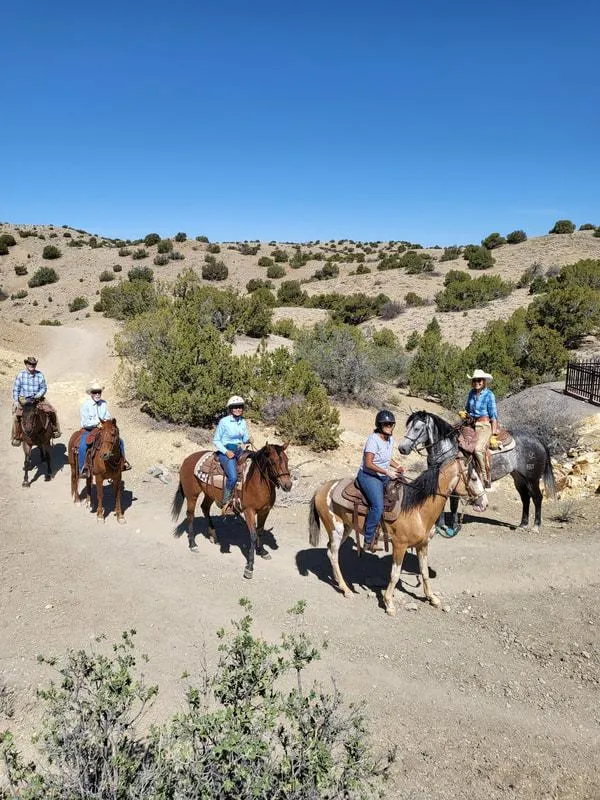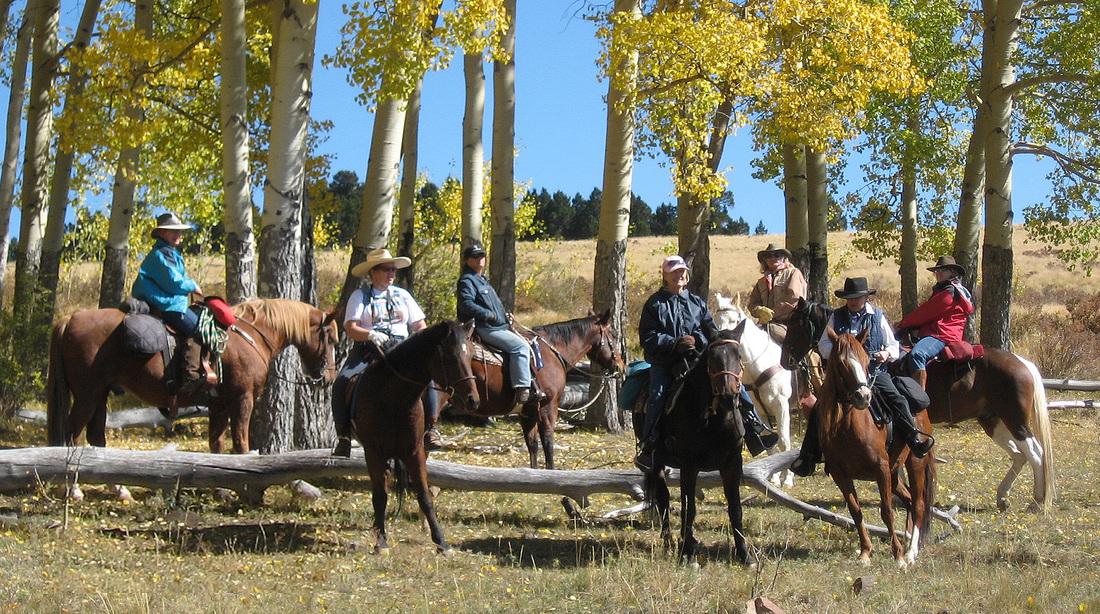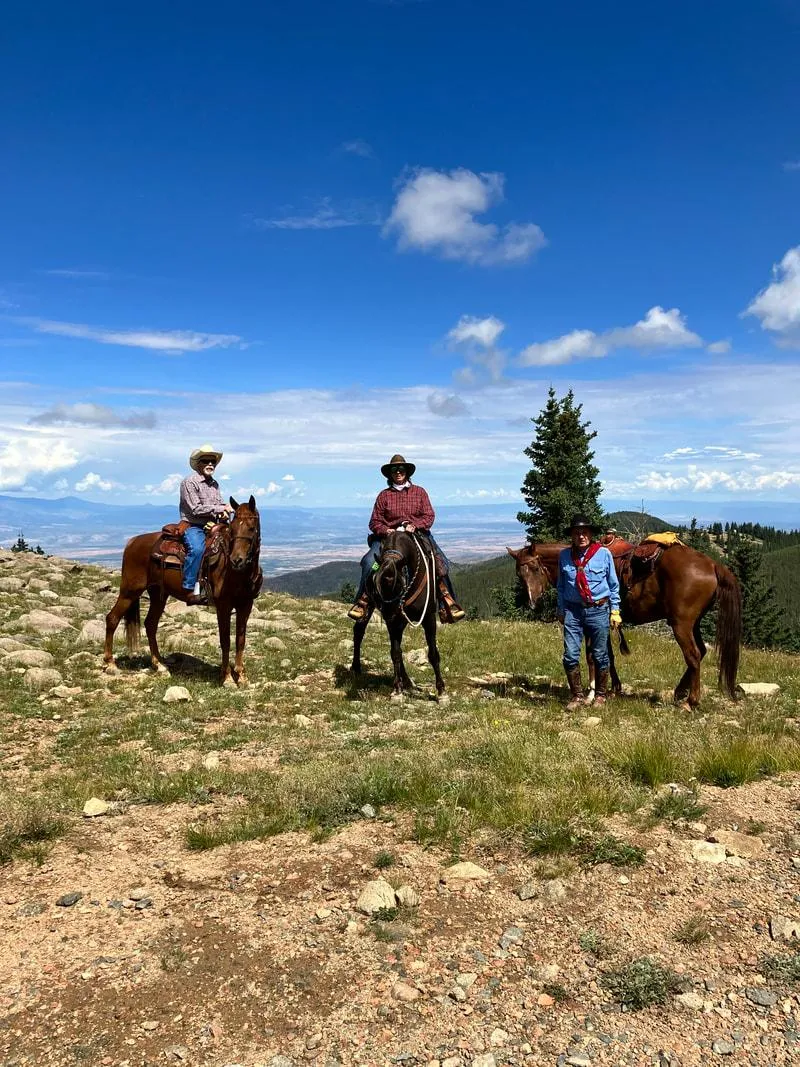Ridge Riders Group Trail Rides
Ridge Riders Trail Rides are organized trail rides for members. We visit places which are old favorites and explore new ground, too.
Join us and Ride!
Because of insurance, the Association's organized group trail rides are open to members only and operate by guidelines designed to keep everyone safe while having a good time. Be familiar with the rules and recommendations outlined below, then come ride! Most but not all of our group trail rides are the first Saturday of the month and within a one-hour haul of Santa Fe, New Mexico.
Riding with Us
Common sense and courtesy are the rules to follow while trail riding to help insure the safety and enjoyment of all riders. Remember, not everyone is an experienced rider, and most horses are not bomb proof.
Trail riding is skilled riding. Before you even think of going on a trail ride, you and your horse should have mastered the basic skills of mounting without others' assistance, stop, go, and turning in both directions. Check your tack to make sure it’s in good repair and effective for the outing. And if driving yourself, practice backing and parking your trailer.
Remember to register in advance and sign our online waiver.
Group trail rides are done for the season,
but we'll look forward to a new line-up by April 2026!
Thank you for joining us in 2025.
Get Ready To Go
• Trail information – date, location, directions, length of ride, terrain description, any special skill requirements ie: crossing water – will be posted on the website once the ride is made available. It is the responsibility of all riders to check the ride information ahead of time. If you have questions about whether a ride is suitable for you and your horse, please ask.
• Register with the Trail Boss for the ride, and provide your name and phone number. If we need to cancel a ride it will be done at least 24 hours ahead of the ride start time and those who made reservations will be called.
At the Trailhead
• Be on time; better yet, be early. Plan ahead by knowing where to go, arriving in plenty of time to finish grooming and tacking before the scheduled departure time – no one likes to wait for a late arrival.
• Riders age 12 and under must be accompanied by an adult.
• Riders must sign in with the Trail Boss at the trailhead; this sign-in will serve as a release (and if someone gets lost, we'll know who it is).
On the Trail
• Don't ride too close to the horse in front of you or lag too far behind. Crowding is dangerous. Lagging behind is just as bad especially in a long line of riders; those at the end of a line won't be able to keep a steady pace. Use a red ribbon tied to the tail on a horse known to kick.
• Warn other riders behind of danger on the trail such as wire, holes, or boggy areas.
• Avoid letting branches snap in the face of the rider following you.
• If you find it necessary to pass a horse or horses, first call out your intentions. NEVER gallop past but walk or trot by quietly and courteously.
• Some horses may balk at crossing water. Don't get off and lead him across as the horse may panic and jump on you. An experienced horse ahead of the balky one will usually give the horse the confidence it needs.
• Be helpful to those who need assistance. Be alert and generous. Often, inexperienced riders welcome good advice tactfully given.
Stopping On the Trail
• If you must dismount for any reason, notify the other riders. All riders should wait until a dismounted rider is back in the saddle before moving on.
• Mounting or dismounting on steep slopes should be done on the uphill side for both the safety of your horse and you. On narrow trails this may mean dismounting on the off side.
• When tying your horse during a rest stop, use a halter and lead rope with a quick-release knot at the level of his eyes or higher. Tie securely and safely: never by reins, never to a dead branch or dead tree trunk, entirely alone, or too close to another horse. Having a horse he knows within eyesight is good.
• Never ground tie on the trail: "A ground-tied horse is a loose horse".
Thou Shalt Nots
• No alcohol or drugs on the trail
• No smoking
• No firearms allowed except those authorized by the Trail Boss
• No stallions
• No dogs
• No littering
Additional Tips:
A rope halter and lead left on under the bridle makes handling and tying easier on the trail.
Helmets are always the safest headwear. Hats protect from the sun and rain. Wear boots with heels. Chaps are protective in brushy country. Bandanas always come in handy for many emergencies.
Bring water and a snack: water for you on the trail and for your horse after the ride. Other handy items to have in saddlebags include a hoofpick, wire cutters, a roll of vet wrap, leather thong for repairs, and a rain slicker.
If your saddle has a back cinch, keep it snug against the belly. If it's loose, it's useless and dangerous: a horse can catch a hind foot in it when kicking at a fly or it can get hung up on brush in rough country.
Use a breastcollar in steep country to keep your saddle from sliding back. A mohair type, rather than leather, is cooler and will not gall a horse.
Use a crupper or breeching if your saddle tends to slip forward when going downhill.
When descending a steep bank, keep the horse pointed straight down. If he starts to slide, he will slide straight down without problem, but if he's angled he could lose his balance.
Going up steep hills it's easier on the horse to zig zag back and forth rather than heading straight up.
If you must lead your horse over an obstacle on the trail, stay to one side so he doesn't jump, slide, or stumble into you.




